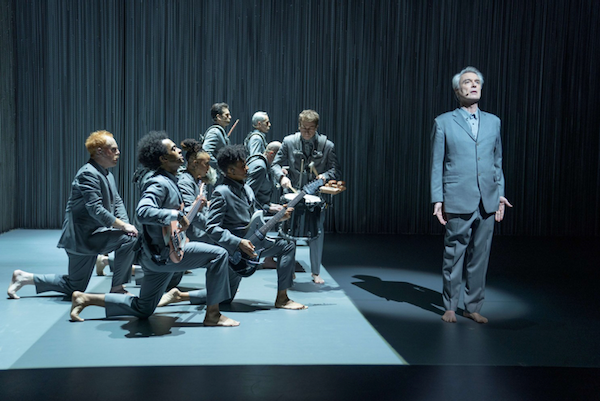Movie review by Greg Carlson
David Byrne and Spike Lee embrace the inevitable comparisons between Jonathan Demme’s “Stop Making Sense” and their recently-released filmed version of “American Utopia.” Lee’s skillful screen translations of more than half a dozen live shows, including “Passing Strange” and “Rodney King,” position him as an ideal choice to capture the immediacy of the in-person event. Like Demme, Lee also takes the viewer to all kinds of places inaccessible to ticket holders, and the result is an exhilarating and exuberant companion to the legendary 1984 concert film.
Byrne maintains his minimalism. He is joined on the stage of Broadway’s Hudson Theatre by eleven performers all dressed in matching outfits and bare feet, and the international troupe gives him a platform from which to make some pointed remarks on behalf of immigrants. It is just one of several instances of editorial commentary rebuking the current administration and its erasure of kindness, compassion, and decency. The musicians are completely untethered and cable-free, and the wireless wizardry combines with Annie-B Parson’s choreography in a sublime union of sound and movement.
Rachel Syme devoted an excellent New Yorker Culture Desk column to the evolution of Byrne’s gray suit, quoting from the performer’s own thoughts on the matter from his 2012 book “How Music Works,” as well as from Pauline Kael’s astonishing review of “Stop Making Sense.” For superfans in search of esotericism, Syme’s article delivers the goods, fully pressed and cleaned. The custom-built costumes in “American Utopia” will make any fashion enthusiast geek out, and Syme’s note that the uniforms suggest “a rare kind of harmony, and a lack of hierarchy” corresponds to the arresting images collected by veteran cinematographer and frequent Lee collaborator Ellen Kuras.
The show’s twenty-one song set spans Byrne’s career discography, but no one record or era dominates. Only five of the selections are from the 2018 studio album from which the musical takes its name. The order and arrangements don’t always thematically cohere, but a narrative emerges, abetted by the anecdotes and narration interspersed between the songs. Messages of hopefulness and positivity coexist with the reality of bleak and disheartening setbacks. In one timely example, Byrne pauses to highlight the importance of voting, urging audience members to go to the polls.
During the introduction to the ensemble’s cover of Janelle Monae’s “Hell You Talmbout,” Byrne reassures the audience that Ms. Monae provided her blessing when approached about the inclusion of her shattering protest song. As a “white man of a certain age,” Byrne’s acknowledgment of his own privilege may not be enough to persuade everyone, but his good intentions, combined with Lee’s own long tradition of speaking and listing names, electrifies the unforgettable moment — especially when Lee adds a triptych of Ahmaud Arbery, Breonna Taylor, and George Floyd as a reminder of the work yet to be done to dismantle institutionalized inequality.
The 68-year-old Byrne of today is less livewire, exposed-nerve, performance-art provocateur and more professorial elder statesman, particularly when delivering observations while holding a human brain prop, but the durable rhythms and elastic lyrics of classic Talking Heads numbers like “Don’t Worry About the Government,” “Born Under Punches (The Heat Goes On),” and “Road to Nowhere” — like any timeless texts — suggest chilling and urgent new meanings during a global pandemic intensified by frightening authoritarianism, racism, and misogyny. The latter song turns out to be the ideal curtain-closer, a joyous march through the audience that captures a moment in time shortly before live performance went dark and imagines the thrill of being able to do it again in the future.
